How our art museums finally opened their eyes to Australian women artists
- Written by Joanna Mendelssohn, Honorary Associate Professor, Art & Design: UNSW Australia. Editor in Chief, Design and Art of Australia Online, UNSW
This is an edited extract from the new book Australian Art Exhibitions: Opening Our Eyes published by Thames & Hudson. It is a longer read, at just over 3000 words.
The 1970s saw major changes in the status of women, which led to more women artists being included in exhibitions, as well as art histories conceived from a feminist perspective. Germaine Greer’s The Female Eunuch was published in the UK in 1970. Although she visited Australia to promote its publication in 1972, it took some time for those running arts organisations to notice the arrival of second-wave feminism.
Linda Nochlin’s provocative essay “Why Have There Been No Great Women Artists?” first appeared in the American publication Art News in January 1971, and found a receptive audience with Australian artists, art historians and junior curators.
In the first half of the 1970s, as part of the wider feminist movement, women artists, art historians and curators began the slow process of recovering their histories, establishing slide registers to create an archive of women artists, and formalising a Women’s Art Movement in Melbourne, 1974; Sydney, 1975 and Adelaide, 1976.
Read more: Still counting: why the visual arts must do better on gender equality
Women’s groups were at first run as collectives, supporting each other to see women as equal players in the art world, as in Ann Newmarch’s screenprint Women Hold Up Half the Sky of 1978. By the mid-1970s there was a proliferation of artist collectives in which women made a significant contribution, including the Tin Sheds Poster Collective at the University of Sydney, Round Space and SAW (South Australian Workshop) in Adelaide.
There were also virtual collectives, as described by photographer Carol Jerrems and writer Virginia Fraser in A Book About Australian Women, 1974, in which artists experimented with photo media to reflect on their lived experiences.
In August 1977, the Women’s Art Movement in Adelaide hosted The Women’s Show for the entire month. This national project was organised by a collective of between 50 to 60 women, with sub-collectives organising women-oriented elements for theatre, music, film, photography, poetry and literature, media, a conference and a visual art exhibition. Another collective arranged childminding.
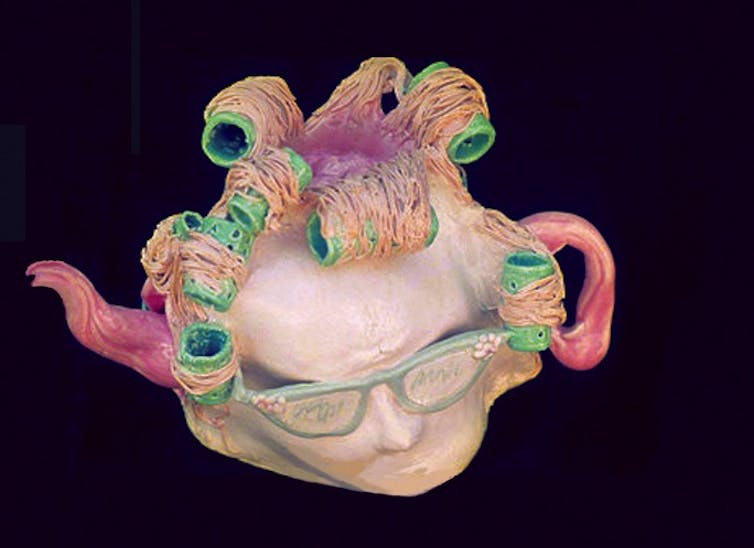 Margaret Dodd, Made to serve, c. 1977, ceramic, earthenware chrome glazed teapot, 12.
Collection Julie Ewington. Exhibited: The Women’s Show Adelaide 1977
Margaret Dodd, Made to serve, c. 1977, ceramic, earthenware chrome glazed teapot, 12.
Collection Julie Ewington. Exhibited: The Women’s Show Adelaide 1977
The exhibition consisted of work by women artists without any culling of entries for a total of over 350 works. The collective opted for a “mixed show”, which meant the exhibition was not ordered by theme, subject or genre, which led to a certain visual incoherence.
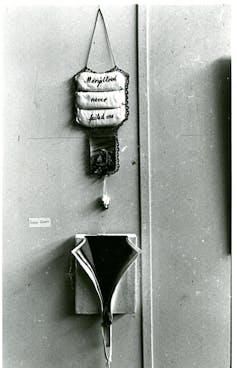 Frances Budden (Phoenix), Relic, 1977. Embroidery, crochet, photogravure and tampons, 72 x 45 (in frame).
tc
Frances Budden (Phoenix), Relic, 1977. Embroidery, crochet, photogravure and tampons, 72 x 45 (in frame).
tc
Margaret Dodds’s Made to Serve, c.1977, a ceramic teapot of a woman whose head, covered in hair-styling rollers, was filled with Bex tablets, while Frances Budden’s Relic, 1977, featured an embroidered text, “Mary’s blood never failed me”, and was hung above the confronting work, Period, 1977, from which menstrual blood flowed. Works by well known artists shared the cavernous viewing space of the Jam Factory.
The journalist, Peter Ward, while sympathetic to the cause, was critical of the uneven nature of the work, writing: “Ideologically, the organisers chose not to discriminate, but to let everyone hang or do their thing. As a result, it turns out to be a kind of women’s newspaper art show”.
This provoked angry responses at the time, but a year later Julie Ewington suggested that “feminists wanting to mount large shows … need experienced professional advice”.
Read more: A riotous, often ribald exploration of feminism's unfinished business
‘Candidly self possessed’
The first International Women’s Year in 1975 was marked by the Ewing and George Paton touring exhibition Australian Women Artists, One Hundred Years: 1840–1940. This was planned by Kiffy Rubbo and Meredith Rogers, but fuelled by the wider energy of the women’s movement.
Paintings, prints and drawings by 39 artists including Clarice Beckett, Margaret Preston, Constance Stokes and Vida Lahey were drawn mainly from public collections, with a mere eight of the 71 exhibits coming from private collections. The exhibition was assembled with all the energy, panache and excitement of rediscovery that marked second-wave feminism and the “need to re-assess and re-establish the position of women in the history of Australian art”.
While the idea of the exhibition was commendable, the actuality revealed the limitations of knowledge about women’s art. The exhibition ended its time-frame in 1945. In the 1970s, art from the 1950s and 1960s was seen as passé.
Janine Burke, the exhibition’s research officer and curator, saw a discernible female aesthetic related to domestic subject matter, which she called “female art”, and found a “problematic treatment of the human body” such as the figure in the landscape with “a pronounced lack of confrontation with the viewer”. Jessie Traill’s etchings of the Sydney Harbour Bridge under construction were not included, nor was there any industrial imagery such as Ethel Spowers’ The Works, Yallourn, 1933.
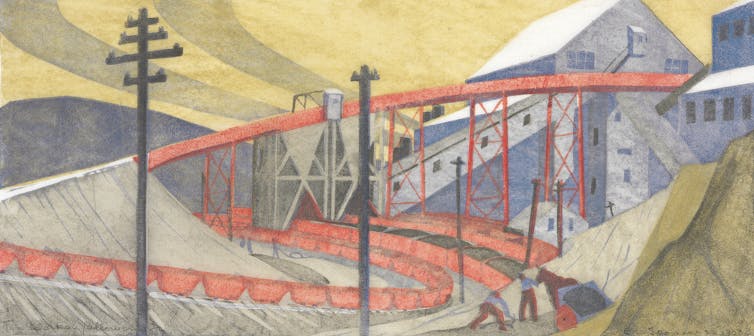 Ethel Spowers, The works, Yallourn 1933, colour linocut.
15.8 x 35.1 cm (block), 24.4 x 43.0 cm (sheet)
ed. 3/50.
National Gallery of Victoria, Melbourne The Joseph Brown Collection. Presented through the NGV Foundation by Dr Joseph Brown AO OBE, Honorary Life Benefactor, 2004 (2004.265)
Ethel Spowers, The works, Yallourn 1933, colour linocut.
15.8 x 35.1 cm (block), 24.4 x 43.0 cm (sheet)
ed. 3/50.
National Gallery of Victoria, Melbourne The Joseph Brown Collection. Presented through the NGV Foundation by Dr Joseph Brown AO OBE, Honorary Life Benefactor, 2004 (2004.265)
Australian Women Artists prompted Maureen Gilchrist to observe in The Age, “we have not in recent years seen anything as far reaching as this picture survey of a century of activity by 39 painters who happen to be women”.
She noted the impact some paintings had on viewers, such as Vida Lahey’s monumental portrayal of two women doing the washing in Monday Morning, 1912, but she singled out Margaret Preston’s Self-Portrait, 1930, writing that her “formal directness is astonishing – the way she plays with echoes of the frame in the planes of the face. But the image itself is also extraordinarily direct, the gaze unflinching … . Never did a woman more fully own the space in which she stands. Never was a woman more candidly self-possessed”.
‘Neglected by the boys’
Three curators, in particular Daniel Thomas and Nicholas Draffin at the AGNSW, and Ian North at the AGSA, were responsible for creating a greater awareness of modernist women artists via focused exhibitions in the 1970s.
The most spectacular exhibition in terms of re-inserting women into art history was the 1973 AGNSW retrospective of works by Grace Cossington Smith curated by Thomas. She had exhibited at Macquarie Galleries since 1932, but as Thomas observed in 1967, “it is astonishing that there has never been an article written on Miss Smith”.
Her national reputation was established with the touring exhibition in which only 26 works out of the 80 selected were in public collections. Forty-nine were held in private collections, while the remainder were still with the artist.
The exhibition was promoted as a special event to honour a still living but very elderly artist in her 81st year. Margaret Jones’s article, “This Year of Grace” was published when Cossington Smith was awarded an OBE for services to art in the 1973 New Year’s Honour’s list. Jones repeated Daniel Thomas’s view that Miss Smith was neglected for many years because “her surroundings may have invested her with a false air of genteel amateurism”.
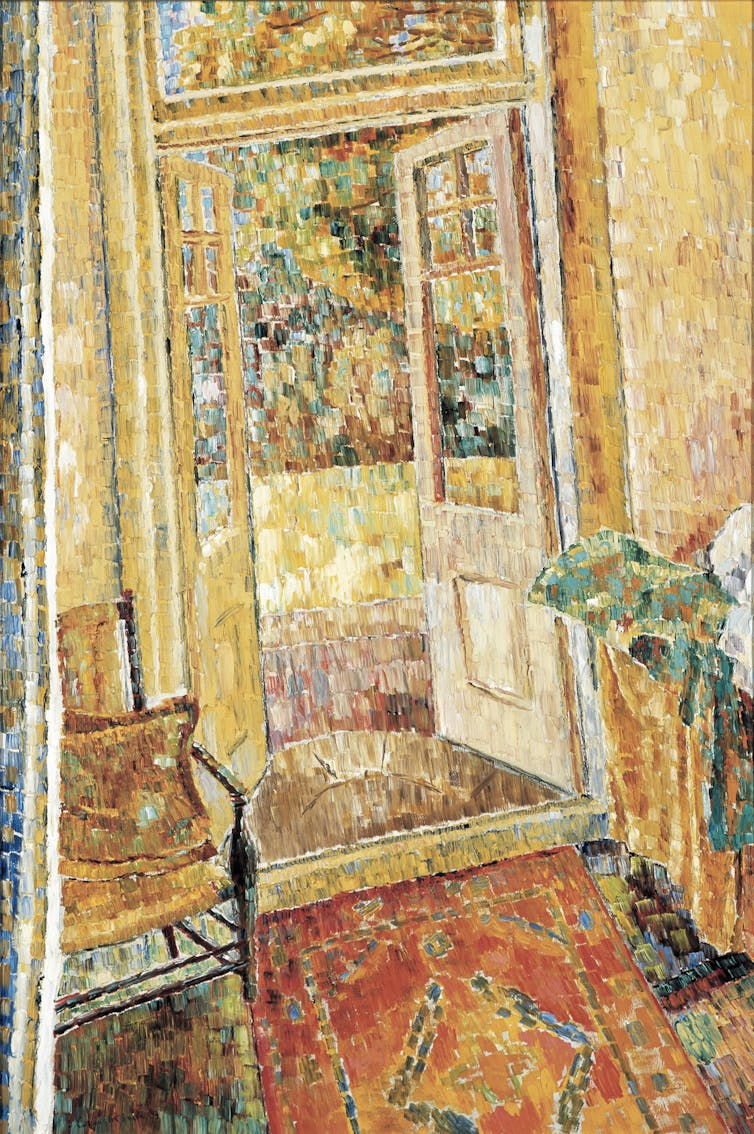 Grace Cossington Smith Door into the Garden 1959 Oil on board 91 x 60.8cm.
Collection: Bendigo Art Gallery Purchased 1959 © Bendigo Art Gallery 2017
Grace Cossington Smith Door into the Garden 1959 Oil on board 91 x 60.8cm.
Collection: Bendigo Art Gallery Purchased 1959 © Bendigo Art Gallery 2017
It was trustees and fellow artists, though, who were the culprits, not art historians as Bernard Smith had drawn attention to her originality in the first edition of Australian Painting in 1962.
The exhibition revealed “Miss Smith … as an innovative and important Australian painter, who developed a talent largely in isolation, finding many of her subjects in the interior of the house in which she has lived for nearly 60 years”.
Thomas said of the exhibition:
I thought she was an incredibly good artist neglected by the boys who ran the Art Gallery of New South Wales, the Artist Trustees, as they had always exhibited their mates, in a way. … The point about Grace Cossington Smith …was the outstandingness of the work … . It was the constant productivity. The constant excellence. It was the long time span of wonderful productivity. A kind of obvious strength and determination, that was the quality that I wasn’t perhaps conscious of, but a lot of visitors noticed it.
In May 1975 Grace Crowley, whose abstract work was not widely appreciated for much of her life, was the subject of the exhibition Project 4. This exhibition of work produced from c.1922–1953, featuring 12 drawings and 25 paintings, some sourced from the collections of the NGV and the NGA, revealed “a persistent pleasure in the flowing line” and a “personal feeling for luminous colour”. Crowley was elderly – her 85th birthday fell while the exhibition was on.
She was so little regarded that only eight of the exhibits came from public and private collections. The remainder came from her own collection. Lenore Nicklin reported when she interviewed the artist in her home, “there were gaps on the walls where her paintings had been removed for the exhibition”.
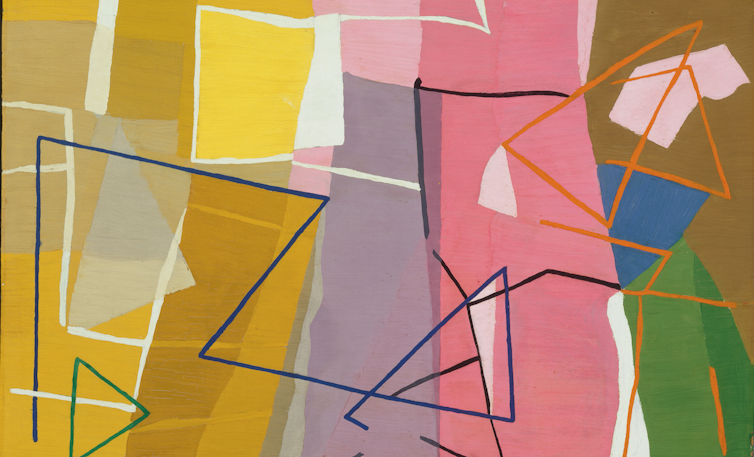 Grace Crowley, Abstract, 1953, oil on hardboard, 61.0 x 87.3 cm.
Art Gallery of New South Wales, Sydney. Bequest of the artist, 1980.
Grace Crowley, Abstract, 1953, oil on hardboard, 61.0 x 87.3 cm.
Art Gallery of New South Wales, Sydney. Bequest of the artist, 1980.
When asked about her exhibition Crowley said, “I’m pleased and I’m terrified. It’s only the second one man show I’ve had in the whole of my life”.
The first was in 1932 at Dorrit Black’s progressive Modern Art Centre in Margaret Street, where Crowley taught until she opened her own art school with Rah Fizelle in 1932. The AGNSW exhibition was also shown at the NGV with a more substantial catalogue. Both exhibitions led to Crowley’s recognition, finally, as one of the most significant abstract painters of her generation.
‘Dorrit who?’
Also in 1975, as the AGSA’s contribution to International Women’s Year, Ian North organised a touring exhibition of Dorrit Black’s work.
North’s rationale in staging the exhibition of 68 works and producing the book was partly to recover the archive – since “very little was written on Black during her lifetime, outside art columns in the press, and she has been largely ignored by most art historians since”.
Following her years in Europe, working with Claude Flight at the Grosvenor School in London and in France with Andre Lhôte, Dorrit Black had set up the Modern Art Centre in Sydney. This was Australia’s first teaching and exhibiting space for Modernism.
As North observed, “the nature of Dorrit Black’s achievement as painter and her activities as an evangelist of the modern movement in Australia have hitherto been unassessed”.
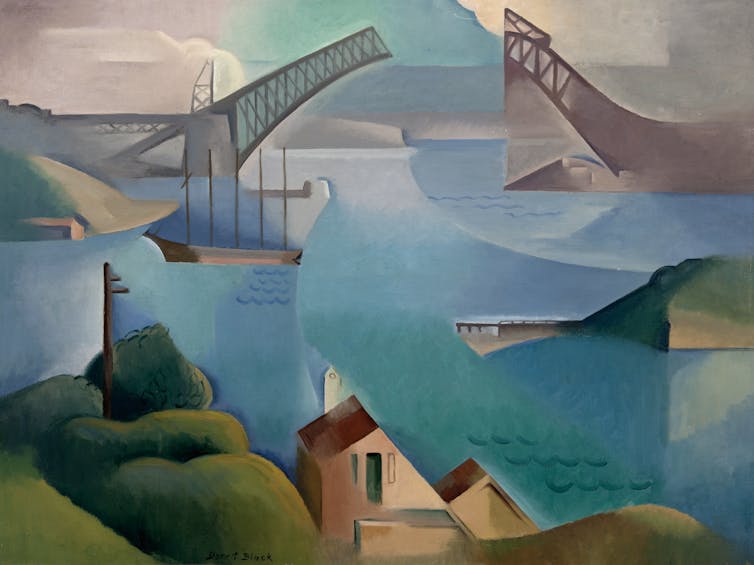 Dorrit Black, The Bridge, 1930.
Oil on canvas on board,
60.0 x 81.0 cm.
Bequest of the artist, 1951, Art Gallery of South Australia, Adelaide.
Dorrit Black, The Bridge, 1930.
Oil on canvas on board,
60.0 x 81.0 cm.
Bequest of the artist, 1951, Art Gallery of South Australia, Adelaide.
North’s judgement was reinforced by Peter Ward’s review which opened with the line: “Dorrit Black, Dorrit Who?”
There was no talk of a female sensibility in this artist’s subjects, rather “Black’s subject matter was mostly the landscape, but there were also some fine still-lifes, remarkably objective portraits of both men and women, and (mainly in the early 1940s) depictions of people at work”.
The best-known modernist artist of this period was Margaret Preston. In contrast to Cossington Smith and Crowley, Preston’s work did not need to be rediscovered. She was readily accepted by both the progressive and the conservative art establishments.
Though she was well known, the depth, the variety and extent of her work was not, which led Ian North in the late 1970s to curate The Art of Margaret Preston, working with Humphrey McQueen and Isobel Seivl. The Art of Margaret Preston was conceived in the spirit of recognising the full worth of a woman artist, even though Preston could never have been described as obscure. When the NGA began to purchase her prints in 1976 they became objects of acute market speculation.
 Margaret Preston, Rock Lily, c.1933.
Woodcut printed in black ink, hand-coloured with gouache, on off-white Japanese paper, 44.9 x 45.8 cm.
Art Gallery of New South Wales, Sydney. Purchased, 1964.
Margaret Preston, Rock Lily, c.1933.
Woodcut printed in black ink, hand-coloured with gouache, on off-white Japanese paper, 44.9 x 45.8 cm.
Art Gallery of New South Wales, Sydney. Purchased, 1964.
Her popular paintings had entered many private collections, which led to North contacting the Australian Women’s Weekly to direct the search to almost every Australian household with an article, “Has anyone seen the missing Preston paintings?”. While some works were discovered in the media, Aboriginal Landscape, 1941, was traced to Yale University.
The Art of Margaret Preston opened in Adelaide on 22 May 1980. The 45 paintings and 45 prints were arranged around key themes – paintings, geometric, modern and Aboriginal-influenced work. The exhibition also presented the full range of her accomplishment as a print-maker – woodcuts, monotypes and gouache stencils. Display cases contained relevant contextual material such as her ceramics, woodblocks and books, unframed photographs and watercolours, and the 1924 Margaret Preston issue of Art in Australia.
Viewers could at last see the full significance of Margaret Preston to Australia’s art history.
Read more: Hands on the wall: were the first artists actually women?
A single exhibition is never the last word on an artist. By 1987, when Roger Butler curated The Prints of Margaret Preston, all the etchings, woodblock prints, monotypes, screenprints and stencils came from the NGA’s own collection, the greatest single holding of her graphic work.
As Preston is such a pivotal figure in Australian art, her work rewards a revisiting every generation. In 2005 Deborah Edwards, with Rose Peel and assisted by Denise Mimmocchi, compiled a comprehensive analysis of Preston’s entire oeuvre in the national touring exhibition, Margaret Preston: Art and Life.
The early works showed the classicism that underpinned her later, apparently artless, modernist studies of bush flowers, explorations of a Japanese aesthetic and Aboriginal colours and form. In reviewing the exhibition Rex Butler wrote:
It is becoming clear as the years go by that it is Margaret Preston and not, say, Sidney Nolan or Fred Williams who was the most important Australian artist of the 20th century. It is she who speaks most powerfully to us today – even ambiguously – of the things that matter most to us: the modern and modernisation, the possibility of a national identity, the reconciliation between whites and Aborigines.
Redefined as major figures
Jane Hylton, Emeritus Curator at the AGSA, has consistently inserted women artists into art history. In 1994, as a part of the celebration of the Centenary of Suffrage in South Australia, she curated South Australian Women Artists, 1890s–1940s.
Work by 28 women painters was displayed in three discrete sections: “the call to Europe: the 1910s and 1920s”, including Marie Tuck, Bessie Davidson and Kathleen Sauerbier; “those who stayed at home” with Jessamine Buxton and Marjorie Gwynn; and “revolt in Adelaide: the 1930s and the 1940s”, the years around the formation of the CAS, with Dorrit Black, Mary P. Harris and Jacqueline Hick. According to Hylton:
South Australian Women Artists broke the record (at that time) of attendance. It was extraordinary. And people were walking around in tears. They were their ‘aunts’ – it was astonishing, the actual importance that it had for people. And I loved that, and that was completely unexpected.
In 2000 Hylton broadened the scope with a national touring exhibition, Modern Australian Women: Paintings and Prints 1925–1945. This included 34 artists, some of whom had worked in Paris and London. The strength and quality of their art led the director, Ron Radford, to wonder why their work had been so readily forgotten when Dobell and Drysdale “had become accepted as the modern Australian masters”.
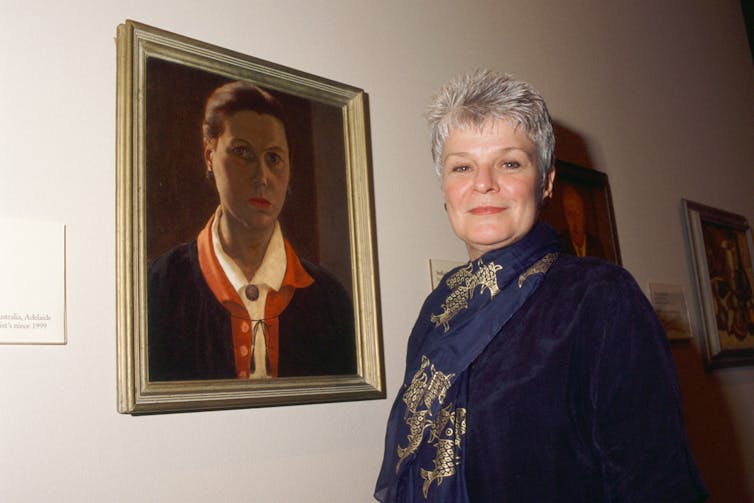 Jane Hylton, curator Modern Australian Women, installation image, 2000.
Author provided
Jane Hylton, curator Modern Australian Women, installation image, 2000.
Author provided
Not all Australian women artists who studied in Europe saw themselves as Modernists, but because they had so readily adopted the pure colours of Neo-impressionism, they were regarded as such on their return to Australia. This led to a certain ambiguity in their standing. For many years publications on Australian art saw Hilda Rix Nicholas as the painter of Étaplian peasant women, as these were the works purchased by public collections on her return to Australia shortly after World War I.
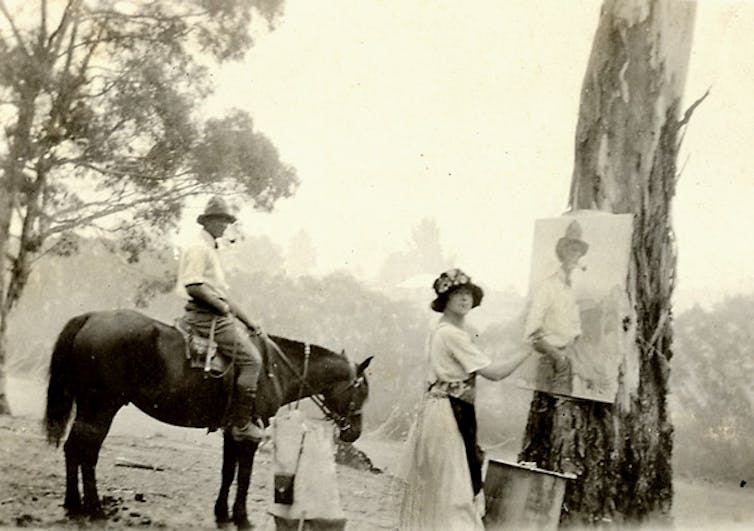 Artist Hilda Rix Nicholas painting in 1922 or 1923.
Wikimedia Commons
Artist Hilda Rix Nicholas painting in 1922 or 1923.
Wikimedia Commons
However Nicholas Draffin’s 1978 exhibition at the AGNSW, based on her entire oeuvre, revealed a far more complex and interesting artist with work ranging from studies made in Morocco, to paintings accepted by the Paris Salon before the War, to the later celebrations of Australian pastoral life.
This exhibition triggered a series of major re-assessments of her work, including John Pigot’s Capturing the Orient: Hilda Rix Nicholas & Ethel Carrick, which demonstrated how these two painters were liberated by the experience of North Africa.
In 2013 Sarah Engledow at the NPG curated Paris to Monaro: Pleasures from the Studio of Hilda Rix Nicholas, which traced the artist’s transition from tragic war widow to painting contented family life in rural NSW. The following year Julie Petersen at Mosman exhibited a small well-crafted survey, Une Australienne: Hilda Rix Nicholas in Paris, Tangier and Sydney. The artist, once seen as an interesting footnote in Australia’s art history, has now been redefined as a major figure.
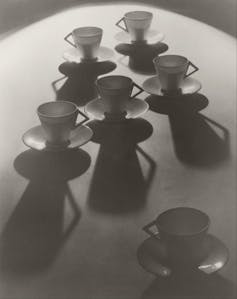 Olive Cotton Teacup ballet, 1935, gelatin-silver photograph, height 50.50 mm, Width: 38.50 mm.
Wikimedia Commons
Olive Cotton Teacup ballet, 1935, gelatin-silver photograph, height 50.50 mm, Width: 38.50 mm.
Wikimedia Commons
In 1985 Barbara Hall curated Olive Cotton: Photographs 1924–1984 for the ACP. Instead of being regarded as Max Dupain’s one-time studio assistant (and former wife) who also took photographs, Cotton was re-assessed as a distinguished modernist photographer, using elements of everyday life in her visual experiments.
The investigation of modernist printmakers, many of them women, had begun in the 1970s when Nicholas Draffin at the AGNSW curated a major exhibition of previously little-known printmakers from the decades between the two World Wars. The AGNSW did not publish a catalogue, but the essence of Draffin’s exhibition lives on in his book, Australian Woodcuts and Linocuts of the 1920s and 1930s.
In 1995 Roger Butler reprised this as part of the National Women’s Art Exhibition where Joan Kerr persuaded almost every Australian public art museum to rehang their collection so that only works by women artists were shown.
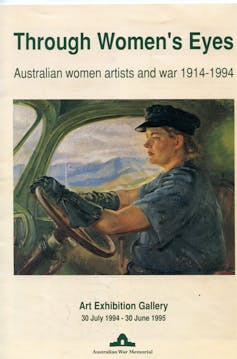 Catalogue of Through Women’s Eyes: Australian Women Artists and War 1914– 1994, Australian War Memorial, Canberra, 1994.
Author provided
Catalogue of Through Women’s Eyes: Australian Women Artists and War 1914– 1994, Australian War Memorial, Canberra, 1994.
Author provided
This resulted in 150 exhibitions mounted across the country. One great revelation of the National Women’s Art Exhibition was the Australian War Memorial’s (AWM) first ever exhibition of work by women, Through Women’s Eyes: Australian Women Artists 1914–1994.
Three women, Nora Heysen, Stella Bowen, and Sybil Craig were appointed official war artists during the Second World War and the AWM continued to actively collect work by women from the late 1970s, although by then much of it was anti-war. Few had been aware of a female presence in the collection until this exhibition.
The National Women’s Art Exhibition spread across the nation. As Jo Holder and Anne Ryan observed, it was a “fragile, provisional construction where the personal is not only political, but also meets past narratives” to reshape “traditional notions of art history”.
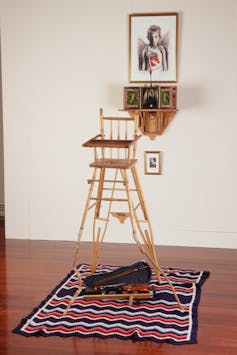 Installation view of Ann Newmarch, Tear, 1992.
Wooden high chair, crutches, violin case, wooden batons, crocheted rug, wooden alter with miscellaneous objects,
framed gelatin silver photograph, framed pastel drawing, dimensions variable. Exhibited: Ann Newmarch: The Personal is Political, Art Gallery of South Australia, 1997.
Private collection.
Installation view of Ann Newmarch, Tear, 1992.
Wooden high chair, crutches, violin case, wooden batons, crocheted rug, wooden alter with miscellaneous objects,
framed gelatin silver photograph, framed pastel drawing, dimensions variable. Exhibited: Ann Newmarch: The Personal is Political, Art Gallery of South Australia, 1997.
Private collection.
That spirit continued in exhibitions such as Ann Newmarch: The Personal is Political, curated by Julie Robinson at the AGSA in 1997. Newmarch moved away from painting to embrace screenprinting as a democratic medium, producing her anti-nuclear series Babies Alive, 1977, and documenting and validating motherhood in Jake and Bruno, 5 years and 5 days, 1977.
Other work spanned her politically-charged Progressive Art Movement era with Nationalize G.M.H. t-shirt, c. 1975, showing the iconic FJ Holden. She also was active in community art projects, especially the anti-rape mural Reclaim the Night, 1980.
Newmarch has long argued that “art should be made out of personal experience not out of "art” concerns". This was evident in Tear, 1992, in which she modified a high chair to have “a very unstable base – almost like a crutches high chair”, as a metaphor for life itself.
She has also confronted her own ageing. When Newmarch turned 50, in 1995, she used the occasion to record the shaving of her head, and then used it as a blank canvas to paint renditions of paintings by well-known male artists.
Australian Art Exhibitions: opening our eyes is a result of the authors’ Australia Research Council Linkage Project grant in partnership with the Art Gallery of New South Wales, National Gallery of Victoria, National Gallery of Australia, Art Gallery of South Australia and Museums Australia.
Authors: Joanna Mendelssohn, Honorary Associate Professor, Art & Design: UNSW Australia. Editor in Chief, Design and Art of Australia Online, UNSW



















